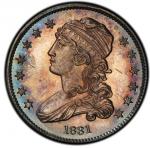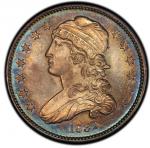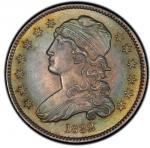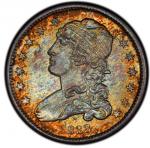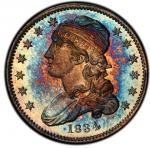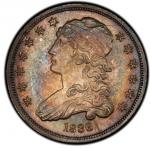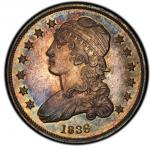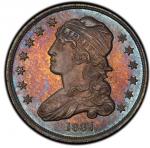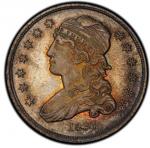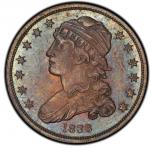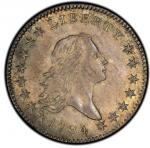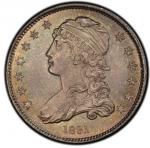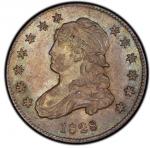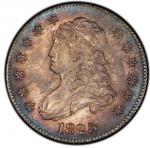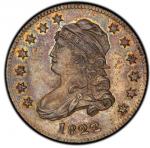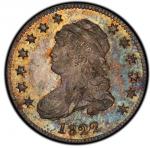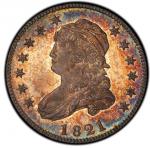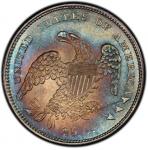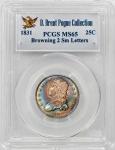The PCGS graded MS-66 16 stars is the finest known (by a considerable margin) of either variety of 1796 dated half dollars. — David Hall, founder of PCGSA coin of historic importance, great rarity, and supreme aesthetics, this is the single finest known 1796 half dollar. Rare as a class, elusive at every grade, there are only a few Mint State examples, of which this is the finest by a very comfortable margin. Its colors are radiant, with shades of light gold, bright blue, magenta, and maize scattered over the lustrous and lightly reflective surfaces by more than two centuries of benign care. The dusk of originality gathers at the rims. The details are complete, with especially strong star centers, great hair detail, and fine eagle feathers everywhere but a long oval on the eagles breast. The reverse, the same one used on the 1796 15 Star type, is now in a slightly later state, with spalling at the right ribbon end a bit more extensive than seen in its previous use. Light cracks have developed above U of UNITED, atop ES of STATES to O of OF, and from CA to rim, where some more spalling is present around C. A faint obverse crack joins stars 1 through 4 at their outer points. Only the most trivial marks and lines are seen, none worthy of mention.A monument of American expansion, the 1796 16 Star half dollar represents a key moment in our history, when the United States finally had too many states to continue to symbolize each of them with an obverse star. Tennessee joined the Union as the 16th state on June 1, 1796. There would be no 17 Star half dollar, nor any other denomination, upon the admission of whatever state that would be (Ohio, as it turned out, in 1803). A new procedure was not settled upon immediately: half dimes of 1797 would be struck with 16 stars, 15 stars, and 13 stars; the latter became the new standard. Dimes and half eagles of 1797 likewise showed this transition, with dimes made in both 16 star and 13 star varieties, while half eagles were coined with obverses that showed either 15 or 16 stars. Half dollars depicted 15 stars in 1797 before adopting the new 13 star standard when the next half dollars were struck in 1801. That new standard caught on last with the dollar denomination, which used both 15 star and 13 star alignments as late as 1798 before adopting a standard 13 star obverse for all issues thereafter.Lelan Rogers recounted the story of his acquisition of this coin, and the companion 1797, in the March 1970 issue of the Empire State Numismatic Associations magazine, The Stater. From the time Rogers first heard of these coins from John Jay Pittman, through an advertisement placed by Arthur Conn in the Numismatic Scrapbook magazine, to tracking down the daughter of collector Abraham Hepner and coming to an agreement on the purchase of this and the 1797 half dollar in the following lot, Rogers tells about a six-month saga that ended with a trip to Washington, D.C. to purchase both coins and bring them back to New York. Rogers article tells of an offhand coin show conversation with John Jay Pittman in November 1968, when Pittman indicated that Rogers two prized Draped Bust halves came from Carl Wurtzbach via Barney Bluestone in 1931. Pittman misremembered; Bluestone had only just begun in the auction business in 1931 and handled no 1796 or 1797 half dollars at auction until 1932 (one less spectacular than this one). This wrinkle in the pedigree chain has thrown off researchers for decades.The provenance becomes clearer with the help of three tidbits that have never been previously strung together. In the Numisma 95 sale, a letter from Charles French of Frenchs in Troy, New York to Mr. Rogers is quoted, mentioning that Frenchs had sold these two half dollars to Abraham Hepner for $1,600, having acquired them from the Judge Curtis Collection. Curtis, it was said, got them from some traveling dealer. Researcher Wayne Burt was kind enough to share with us an advertisement from the June 1951 issue of The Numismatist offering The Two Rarest Half Dollars, namely 1796 16 Stars, in Perfect Condition, Uncirculated with Proof-Like Lustre and a 1797 of the same description, both formerly from the Brand and B.G. Johnson Collections. The timing of the publication of this advertisement is less than six months after the death of Judge Arthur F. Curtis of Delhi, New York, a hamlet near Frenchs home base of Troy. Rather than coming from Wurtzbach and Bluestone, it appears both of these half dollars were in the immense Virgil Brand Collection, which was dispersed by Burdette G. Johnson of St. Louis in the mid to late 1930s. Curtis acquired them together, perhaps from Johnson directly at some coin convention or other. Before 1995, neither of them had sold at auction since at least the time Brand acquired them in the early part of the 20th century, or perhaps even the end of the 19th.Of the two varieties of 1796 half dollar, the 16 Star obverse is considered the rarer one by a significant margin. Just three Mint State 1796 16 Star half dollars have been certified by PCGS, with one each in grades MS-62, MS-64, and MS-66. At the MS-66 grade level, just one other example of this entire design type has been certified: the coin offered in the next lot, reunited in the D. Brent Pogue Collection in 1999 after being together in the Brand, Curtis, Hepner, and Rogers collections for close to a century.


